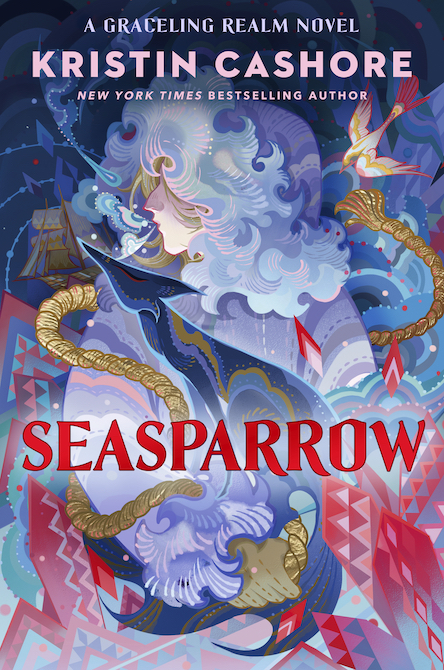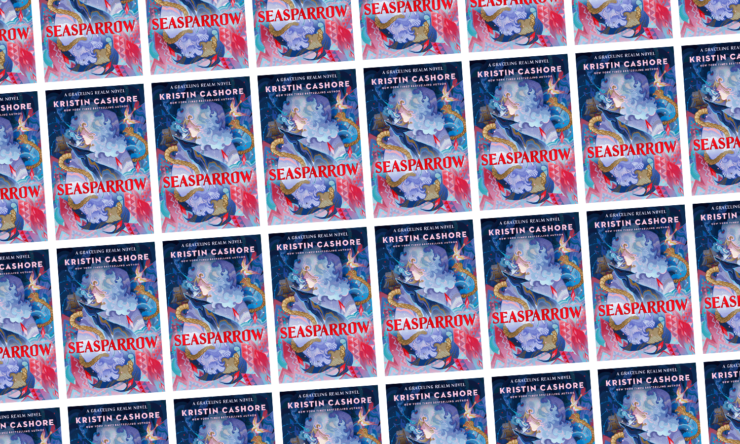I do not think I’m the only person who’s slowly and surely fallen a bit in love with Hava over the last few novels in Kristin Cashore’s Graceling Realm series. The spy (and secret half-sister of Queen Bitterblue) moved around the edges in Bitterblue, making the most of her Grace (an unlikely and unique power) of hiding and disguise. In last year’s Winterkeep, her role in Bitterblue’s court became rather more prominent—not a position with which Hava was comfortable.
She takes center stage on her own terms in Seasparrow, which picks up after the explosive end of Winterkeep. The whole world is facing something entirely new: the existence of a weapon far beyond anything previously in existence. Hava’s task is to translate documentation of the weapon’s development. Bitterblue’s is to decide what to do with that information.
But readers of any of the first four Graceling Realms novels will know what they’re really in for. This is a Kristin Cashore novel. There is a plot—a taut and harrowing story—but we are here for a different kind of journey: that of a young woman learning some difficult and necessary truths.
The events of Winterkeep lead directly into the beginning of Seasparrow, and while Cashore does a great job of reminding you of all the important elements, it will land much differently if you’ve experienced the story so far. It’s not just a matter of plot; it’s a matter of how everyone, in these books, has terrible parents and has been through hell; how Bitterblue is debilitatingly seasick and recovering from kidnapping; how Hava just had a near-death experience and is very much still processing that.
Buy the Book


Seasparrow
All of this is to say: As Seasparrow opens, everyone is at a turning point, and they are also, quite literally, at sea. En route home, the queen and her companions are on board a ship called the Monsea, headed back to the country of the same name under the capable leadership of captain Annet and her crew of extremely competent women and a few scrappy lads.
If you do not care about life on a ship, about the intricacies of hierarchies and climbing the rigging; if you would never lie on your back in a lifeboat, watching the patches of sail stand bright against a blue sky—if none of that sings to you, you may from time to time wish Hava were not so in love with this ship. But Cashore’s writing is fueled with love and a specific experience: the Arctic Circle, an “expeditionary residency program” during which participants live and work on board a ship that sails around Svalbard. (Cashore details this a bit in her acknowledgements, which you should certainly read.) She wants you to see and see what she saw and felt, whether the beauty and danger of the ice or of polar bears; whether the necessity of doing what your captain says or the inevitability of frayed tempers or the pure privacy of perching yourself in the rigging with no one else around.
On the Monsea, Hava works to translate the formulas that will allow Bitterblue to make the dreaded zilfium weapons—or at least to understand how they can be made. She works alone, but she also talks to the crew, curious and observant as ever. Her watching uncovers a secret: someone has kidnapped and hidden one of the telepathic blue foxes of Winterkeep. The fox is heartbreaking and vulnerable; Hava is furious, and takes the fox into her care. The story of why a member of the crew kidnapped the fox in the first place ties into the rest of the narrative quite neatly, but for Hava it is a lesson in justice, in setting aside vengeance and pain for pain’s sake, and in understanding that freedom means different things to different people.
The bigger story here is about power and subtlety, about what to do with dangerous knowledge and how to be honest in the face of truly reasonable fears. It is also, quite plainly, about survival. When the Monsea veers off course and runs aground, the outcome is terrible. (A side note to animal lovers: Brace yourselves.) Everyone left piles into small boats, and from then on, the immediate struggle is to survive—to survive cold and hunger and bears and exhaustion and fear.
A trek across the ice is a classic scene in SFF. Victor Frankenstein traveled across his own ice. The journey of Estraven and Genly Ai in Le Guin’s The Left Hand of Darkness is positively iconic; Lyra Silvertongue’s journey to the North in The Golden Compass is fraught and heartbreaking. But the crew of the Monsea experience the north differently. They have community. They have each other, even those with bad blood. They also have a litter of tiny fox kits, born from the kidnapped fox, who is not recovered enough to take much interest in her offspring. Responsibility for the kits is Hava’s—until she figures out how to share it.
This is the kind of book where someone setting a fox kit into a friend’s hands might make a reader burst into tears. For much of her life, Hava has believed that her Grace is hiding—it’s how she survived, as her mother kept her existence a secret from her father, the terrible King Leck. (Of all the terrible parents in Cashore novels, Leck—Graced with the ability to control people—was the worst.) It’s what makes her such a good spy, her ability to stand in plain sight and make people see something else entirely. It served her well when she was forced to raise herself from the age of eight.
But there’s so much you can’t learn in an existence like that—including who you really are, what you really want, what really matters to you, and how you want to be with other people. Seasparrow is, at its deepest heart, a book about kindness—in large part, it’s a story about learning to be kind to yourself. Fierce, sharp, smart, and prickly as hell, Hava finds a new experience in her care of the blue fox and her kits. They are tiny and vulnerable and fragile and needy; they are all the things Hava was never able to be. They are so much easier to love than people, who are slippery and selfish and elusive.
People with whom you’ve been through hell, though—that changes a relationship. Cashore understands how trauma can bond people, how hurt can fester but also how it can be diverted into truth. She writes with clarity and love about people who hold rare positions in their world—queens, spies, captains—the same way she writes about deckhands and telepathic foxes. Seasparrow is a cathartic story, one that allows its heroine to understand how much she’s been through and how much she needs. It makes gentle, careful space for the beginnings of a love story between two people who understand each other’s pain as well as each other’s capacity for love. And there’s room for a great love of ships and science, for curiosity, for the sweetness of Bitterblue’s relationship with Giddon and for the joined beauty and terror of the cold, cold north.
As clearly and plainly as the cold could kill Hava and her companions, Seasparrow never feels like a humans vs. nature book. It’s a humans-working-together book, a book about community and support and learning to share your burdens. It’s three books in one—sea journey, ice journey, and aftermath—and while it feels like a complete thought, I’m a selfish reader. I hope there’s more Hava yet to come.
Seasparrow is published by Dutton Books for Young Readers
Read an excerpt here
Molly Templeton lives and writes in Oregon, and spends as much time as possible in the woods. Sometimes she talks about books on Twitter.











How I love this series of books. And you’re right – each novel is about the healing of the broken. They bring such joy. I cried through most of the second half!